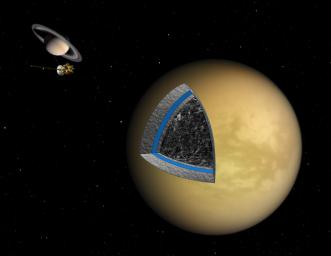
|
Titan’s Cool and Sluggish Interior (Artist’s Concept)
- Click the image above for a larger view
- Full-Res JPEG (3300 x 2550) (346.1 kB)
- Full-Res TIFF (3300 x 2550) (25.2 MB)
Caption:
This artist's illustration shows the likely interior structure of Saturn's moon Titan deduced from gravity field data collected by NASA's Cassini spacecraft. The investigation by Cassini's radio science team suggests that Titan's interior is a cool mix of ice studded with rock, though the outermost 500 kilometers (300 miles) appear to be ice essentially devoid of any rock. Many planets and moons, including the Earth, evolve into a body with a clearly distinct rocky core. This radio science investigation suggests Titan's interior, cool and sluggish, failed to allow the interior to separate into completely differentiated layers of ice and rock.
In addition to the hazy surface of Titan (yellow), the layers in the cutaway show an ice layer starting near the surface (light gray), an internal ocean hypothesized from other Cassini data (blue), another layer of ice (light gray) and the mix of rock and ice in the interior (dark gray). In the background are the Cassini spacecraft and Saturn, not to scale.
Background Info:
The Cassini-Huygens mission is a cooperative project of NASA, the European Space Agency and the Italian Space Agency. JPL, a division of Caltech, manages the project for NASA's Science Mission Directorate in Washington. The Cassini orbiter was designed, developed and assembled at JPL. Cassini's radio science subsystem has been jointly developed by NASA and the Italian Space Agency.
For more information about the Cassini-Huygens mission visit http://www.nasa.gov/cassini and http://saturn.jpl.nasa.gov .
Cataloging Keywords:
| Name | Value | Additional Values |
|---|---|---|
| Target | Titan | Saturn |
| System | Saturn | |
| Target Type | Satellite | Planet |
| Mission | Cassini-Huygens | |
| Instrument Host | ||
| Host Type | ||
| Instrument | ||
| Detector | ||
| Extra Keywords | Artwork, Atmosphere, Color, Haze, Radio | |
| Acquisition Date | ||
| Release Date | 2010-03-11 | |
| Date in Caption | ||
| Image Credit | NASA/JPL | |
| Source | photojournal.jpl.nasa.gov/catalog/PIA12843 | |
| Identifier | PIA12843 | |
